同济大学:《经济学》课程教学资源(教案讲义)Ch01 The Fundamentals of Economics(负责人:李永)
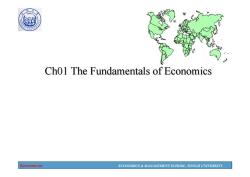
190 Cho1 The Fundamentals of Economics Economics ECONOMICS MANAGEMENT SCHOOL,TONGJI UNIVERSITY
Economics ECONOMICS & MANAGEMENT SCHOOL, TONGJI UNIVERSITY Ch01 The Fundamentals of Economics Ch01 The Fundamentals of Economics

1907 01-3 1.1 What is economics? Economics is the study of how societies choose to use scarce productive resources that have alternative uses,to produce commodities of various kinds, and to distribute them among different groups. Economics is the study of how society manages its scarce resources. Economics ECONOMICS MANAGEMENT SCHOOL,TONGJI UNIVERSITY
Economics ECONOMICS & MANAGEMENT SCHOOL, TONGJI UNIVERSITY 01-3 • Economics is the study of how societies choose to use scarce productive resources that have alternative uses, to produce commodities of various kinds, and to distribute them among different groups. • Economics is the study of how society manages its scarce resources. 1.1 What is economics?
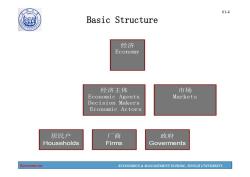
A90 01-4 Basic Structure 经济 Economy 经济主体 市场 Economic Agents Markets Decision Makers Economic Actors 居民户 厂商 政府 Households Firms Goverments Economics ECONOMICS MANAGEMENT SCHOOL,TONGJI UNIVERSITY
Economics ECONOMICS & MANAGEMENT SCHOOL, TONGJI UNIVERSITY 01-4 Basic Structure 居民户 Households 厂商 Firms 政府 Goverments 经济主体 Economic Agents Decision Makers Economic Actors 市场 Markets 经济 Economy
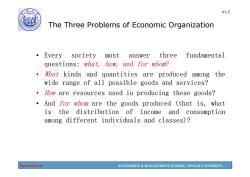
01-5 v的 The Three Problems of Economic Organization ·Every society must answer three fundamental questions:what,how,and for whom? What kinds and quantities are produced among the wide range of all possible goods and services? How are resources used in producing these goods? And for whom are the goods produced (that is,what is the distribution of income and consumption among different individuals and classes)? Economics ECONOMICS MANAGEMENT SCHOOL,TONGJI UNIVERSITY
Economics ECONOMICS & MANAGEMENT SCHOOL, TONGJI UNIVERSITY 01-5 The Three Problems of Economic Organization • Every society must answer three fundamental questions: what, how, and for whom? • What kinds and quantities are produced among the wide range of all possible goods and services? • How are resources used in producing these goods? • And for whom are the goods produced (that is, what is the distribution of income and consumption among different individuals and classes)?
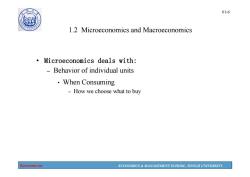
01-6 1.2 Microeconomics and Macroeconomics Microeconomics deals with: Behavior of individual units ·When Consuming -How we choose what to buy Economics ECONOMICS MANAGEMENT SCHOOL,TONGJI UNIVERSITY
Economics ECONOMICS & MANAGEMENT SCHOOL, TONGJI UNIVERSITY 01-6 1.2 Microeconomics and Macroeconomics • Microeconomics deals with: – Behavior of individual units • When Consuming – How we choose what to buy
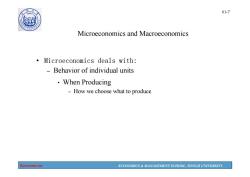
1907 01-7 3树 Microeconomics and Macroeconomics Microeconomics deals with: Behavior of individual units ·When Producing -How we choose what to produce Economics ECONOMICS MANAGEMENT SCHOOL,TONGJI UNIVERSITY
Economics ECONOMICS & MANAGEMENT SCHOOL, TONGJI UNIVERSITY 01-7 • Microeconomics deals with: – Behavior of individual units • When Producing – How we choose what to produce Microeconomics and Macroeconomics
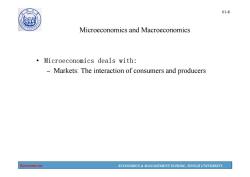
01-8 0 © Microeconomics and Macroeconomics Microeconomics deals with: Markets:The interaction of consumers and producers Economics ECONOMICS MANAGEMENT SCHOOL,TONGJI UNIVERSITY
Economics ECONOMICS & MANAGEMENT SCHOOL, TONGJI UNIVERSITY 01-8 • Microeconomics deals with: – Markets: The interaction of consumers and producers Microeconomics and Macroeconomics
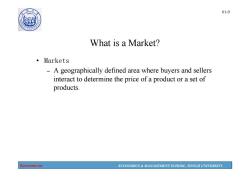
01-9 1907 What is a Market? ·Markets -A geographically defined area where buyers and sellers interact to determine the price of a product or a set of products. Economics ECONOMICS MANAGEMENT SCHOOL,TONGJI UNIVERSITY
Economics ECONOMICS & MANAGEMENT SCHOOL, TONGJI UNIVERSITY 01-9 What is a Market? • Markets – A geographically defined area where buyers and sellers interact to determine the price of a product or a set of products

01-10 0 砂 What is a Market? Markets vs.Industries -Industries are the supply side of the market. Economics ECONOMICS MANAGEMENT SCHOOL,TONGJI UNIVERSITY
Economics ECONOMICS & MANAGEMENT SCHOOL, TONGJI UNIVERSITY 01-10 What is a Market? • Markets vs. Industries – Industries are the supply side of the market
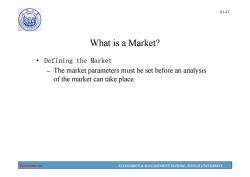
1907 01-11 What is a Market? ·Defining the Market The market parameters must be set before an analysis of the market can take place. Economics ECONOMICS MANAGEMENT SCHOOL,TONGJI UNIVERSITY
Economics ECONOMICS & MANAGEMENT SCHOOL, TONGJI UNIVERSITY 01-11 What is a Market? • Defining the Market – The market parameters must be set before an analysis of the market can take place
按次数下载不扣除下载券;
注册用户24小时内重复下载只扣除一次;
顺序:VIP每日次数-->可用次数-->下载券;
- 同济大学:《经济学》课程教学资源(试卷习题)期终考试试卷(B卷)答案.pdf
- 同济大学:《经济学》课程教学资源(试卷习题)期终考试试卷(B卷)试题.pdf
- 同济大学:《经济学》课程教学资源(试卷习题)期终考试试卷(A卷)答案.pdf
- 同济大学:《经济学》课程教学资源(试卷习题)期终考试试卷(A卷)试题.pdf
- 安徽科技学院:《会计信息系统》课程教学资源(PPT课件)第七章 ERP应用概述.ppt
- 安徽科技学院:《会计信息系统》课程教学资源(PPT课件)第六章 会计信息系统审计.ppt
- 安徽科技学院:《会计信息系统》课程教学资源(PPT课件)第五章 会计信息系统的建设与管理.ppt
- 安徽科技学院:《会计信息系统》课程教学资源(PPT课件)第四章 其他业务核算子系统.ppt
- 安徽科技学院:《会计信息系统》课程教学资源(PPT课件)第三章 报表子系统.ppt
- 安徽科技学院:《会计信息系统》课程教学资源(PPT课件)第二章 账务处理子系统.ppt
- 安徽科技学院:《会计信息系统》课程教学资源(PPT课件)第一章 会计信息系统概述(主讲教师:王伟).ppt
- 安徽科技学院:《会计信息系统》课程教学资源(试卷习题)综合理论练习题及答案.doc
- 安徽科技学院:《会计信息系统》课程教学资源(试卷习题)复习思考题答案.doc
- 安徽科技学院:《会计信息系统》课程教学资源(试卷习题)练习题8.doc
- 安徽科技学院:《会计信息系统》课程教学资源(试卷习题)练习题7.doc
- 安徽科技学院:《会计信息系统》课程教学资源(试卷习题)练习题6.doc
- 安徽科技学院:《会计信息系统》课程教学资源(试卷习题)练习题5.doc
- 安徽科技学院:《会计信息系统》课程教学资源(试卷习题)练习题4.doc
- 安徽科技学院:《会计信息系统》课程教学资源(试卷习题)练习题3.doc
- 安徽科技学院:《会计信息系统》课程教学资源(试卷习题)练习题2.doc
- 同济大学:《经济学》课程教学资源(教案讲义)Ch02-1 Supply and Demand.pdf
- 同济大学:《经济学》课程教学资源(教案讲义)Ch02-2 Applications of Supply and Demand.pdf
- 同济大学:《经济学》课程教学资源(教案讲义)Ch03 Demand and Consumer Behavior.pdf
- 同济大学:《经济学》课程教学资源(教案讲义)Ch04 Producer Behavior.pdf
- 同济大学:《经济学》课程教学资源(教案讲义)Ch05 Analysis of Cost.pdf
- 同济大学:《经济学》课程教学资源(教案讲义)Ch06-1 Analysis of Perfectly Competitive Markets.pdf
- 同济大学:《经济学》课程教学资源(教案讲义)Ch06-2 Imperfect Competition.pdf
- 同济大学:《经济学》课程教学资源(教案讲义)Ch07 General Equilibrium and Economic Efficiency.pdf
- 同济大学:《经济学》课程教学资源(教案讲义)Ch08 Market For Factors of Production.pdf
- 同济大学:《经济学》课程教学资源(教案讲义)Ch10 Overview of Macroeconomics.pdf
- 同济大学:《经济学》课程教学资源(教案讲义)Ch09 Externalities and Public Goods.pdf
- 同济大学:《经济学》课程教学资源(教案讲义)Ch11 National Income Accounting.pdf
- 同济大学:《经济学》课程教学资源(教案讲义)Ch12-1 Consumption and Investment.pdf
- 同济大学:《经济学》课程教学资源(教案讲义)Ch12-2 The Determination of Equilibrium Output.pdf
- 同济大学:《经济学》课程教学资源(教案讲义)Ch13 Money Market Equilibrium.pdf
- 同济大学:《经济学》课程教学资源(教案讲义)Ch14 Outputs and Money Market - IS-LM Model.pdf
- 同济大学:《经济学》课程教学资源(教案讲义)Ch15 Aggregate Demand And Supply.pdf
- 同济大学:《经济学》课程教学资源(教案讲义)Ch16 Economic Growth.pdf
- 吉林大学:《中央银行业务管理》课程教学资源(PPT课件)第一章 中央银行制度的形成和发展.ppt
- 吉林大学:《中央银行业务管理》课程教学资源(PPT课件)第七章 中央银行的其他业务.ppt
